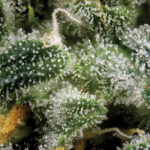“Terpenes” is a term thrown around a lot in cannabis circles, although not everyone knows what they are. But if you’ve taken a walk in a pine forest, enjoyed aromatherapy at yoga class, or fended off mosquitoes with a citronella candle, then you’ve experienced terpenes.
Terpenes are a class of molecules responsible for many aromas and flavors found in plants. “When you smell a flower, what you are smelling is the terpene profile of the flower,” explained Kevin Koby, chief scientific officer at Abstrax Tech, a California-based company that specializes in sourcing, processing, and formulating terpenes. “Those volatile molecules are coming out in the air and interacting with the olfactory system.” Terpenes act as a life-preserving force for plants, either by deterring insects or promoting pollination, or through other properties. They are common in food, natural medicine, and essential oils.
With more than 120 different terpenes identified in the cannabis plant, these molecule compounds also play a huge role in how cannabis works on the human body. When people take in cannabis, they experience what’s known as the entourage effect. Not only are their neurological receptors interacting with the well-known cannabinoids THC and CBD — each of which triggers different effects — but they also are reacting to the plant’s terpenes. Each compound intensifies the other, creating a cocktail of cannabinoids and terpenes that’s stronger than its separate parts.
The problem is processing cannabis for edibles or vaping products squeezes terpenes out of the equation. What remains are flavorless extracts with THC and CBD — no distinctive flavors, no specific experiences. That leaves it to companies like Abstrax Tech to reintroduce terpenes into the cannabis equation. They typically do so by harvesting other plants — such as oranges or rose petals — to get the same terpenes as those found in cannabis for less money.
Within this biochemical challenge lies the ultimate marketing opportunity for cannabis manufacturers: the ability to differentiate products. Each terpene molecule has distinct properties, which means they can elicit an almost infinite array of tastes and reactions. Research has shown limonene carries a citrusy scent and is energizing, linalool is found in lavender and has a calming effect, and pinene smells like Christmas and possesses anti-inflammatory properties.
By introducing different constellations of terpenes, producers can customize cannabis to consumers’ most detailed specifications. “One customer told me that he loved the taste of a certain kind of ice cream when he was young,” said Koby. “I could recreate that flavor from terpenes.”
Those kinds of unique properties are exactly how cannabis companies can build distinctive, recognizable brands. Think about McDonald’s. Without its special sauce, the Big Mac would just be a cheeseburger. Terpenes are the “special sauce” of the cannabis industry.
Just as McDonald’s got a pop by adding bacon to the Big Mac, cannabis producers can build excitement by introducing new blends that are reminiscent of a midday slushy or a fruit combination. Terpenes also allow companies to expand into different product lines, such as candles or lotions.
Most importantly, terpenes are the key to creating a consistent brand experience. Consumers expect all their products to taste, feel or look the same every time. However, horticulture is a finicky science, and given the likelihood of genetic drift — when genes disappear over time — no farmer can guarantee the same cannabis crop each season. The only way to replicate cannabis’s properties is to standardize the process of distilling terpenes from plants. Each step is crucial, since the tiniest shift in formulation could alter the intensity of an adult consumer’s experience.
As with so many elements of our nascent industry, marketing cannabis comes with its own special parameters. Although cannabis generated between $7 billion and $10 billion in 2017, it’s still a young market with lots of companies competing to sell to an audience that, increasingly, hasn’t used cannabis before. For many products, the right blend of terpenes just might be the answer.













[…] who professionally cultivate cannabis are very familiar with the importance of terpenes in plants. To improve their chance of survival in nature and repel predators, plants produce […]
[…] who professionally cultivate cannabis are very familiar with the importance of terpenes in plants. To improve their chance of survival in nature and repel predators, plants produce […]